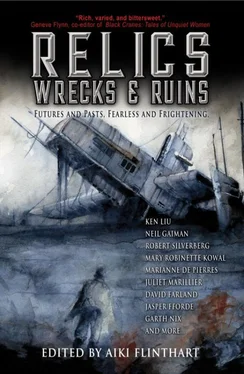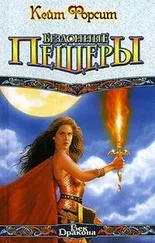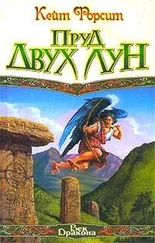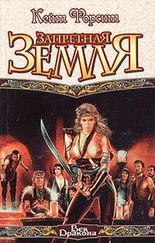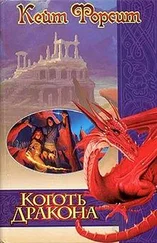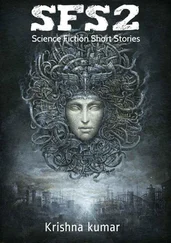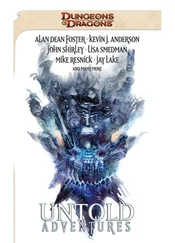Her mother said, “Why don’t you run on up to bed?”
Without words to even think about everything that had happened, Kim nodded. Later there would be time to talk, but she felt too battered for thought. Kim hugged her parents for a long time and dragged herself up the stairs to her room.
She hopped over the line of salt, then turned. Squatting, she brushed the barrier aside.
Kim turned out the lights and crawled into bed.
She left the door open.

Pattern on Stone
By James SA Corey
Excerpt of remarks by Yva Alenea Brooks delivered to the Umarra Institute, Bercale-3, August 15 2751 (relative standard)
The purpose of our mission was to examine the Carrath artifact discovered on Ouroboros-4 seven standard years ago. As with previous relics of its kind, this took the form of metamorphic rock, apparently of local origin, with a complex of channels and penetrations that either create or contain an energetic field effect. The effect has been compared to neural activity, but the gross similarities between the Carrath patterns and signaling systems of either Earth- or Eunollia-based life-trees breaks down quickly at a finer level of analysis. The signature peculiarity of the field effect is its vulnerability to slipdrive transport. The first four Carrath artifacts were effectively erased in the attempts to take them for analysis on Earth, Tanabea, and Kors. It is this property that makes them as enigmatic and troubling as they are.
While there is little doubt that the analytic powers of our great institutions would reveal a great deal more than we presently understand about the stonemakers, what exactly they were, and the purpose and structure of the artifacts they left behind, it is for practical reasons impossible. We have the object. We have the means to decode it. But we can’t put the two together. Someday we may discover a Carrath stone already on a well-settled and civilized planet. Or we may invest in building up a solar system in which a Carrath stone exists. Until that day, however, research teams such as my own are the best hope for understanding the mysteries that these objects represent. The stones are fascinating to me and have been the center of my own research for eighty years standard, in part because I became focused on—and to a degree seduced by—the idea of something so tantalizingly strange and also so uniquely and intimately out of reach.
#
Slipdrive pilot Peros Danari Williamson woke in his old bed and his new body. This regeneration had darker skin than he’d had before, with thick, black hair on his chest and arms, and, he suspected, the potential of a fairly epic mustache. He’d spent the last fifty years clean-shaven, and the prospect of getting a little facial hair back pleased him more than he let on. He stretched, enjoying the younger muscles and ligaments, the pain-free joints.
The smell of tea wafted in from the little kitchenette. Nadima making her usual breakfast. His sense of smell once again undimmed by age, he let the memories of the same scent of tea carry him back to the common house on Molos, the little flat in London back on Earth, and even the mud-and-bamboo hut on Lopporo that had been their first home after they’d married, two hundred years before. In all the places they had lived their shared life, Nadima has always liked the same smoky tea in the morning.
He dressed himself in a pair of canvas trousers and a casual tunic. The flooring was textured stone, and cool under his bare feet. In the kitchenette, Nadima sat on a tall stool. Her hair was white with just a hint of yellow that made her look always a little unwashed. She wore a suit jacket and a broad, dark skirt with laced boots that said she was ready to travel. Peros didn’t hide his pleasure at that.
“Good,” he said.
She turned to him as if just noticing he was there. “What is?”
He gestured at her—index and middle fingers together sweeping up and down her body as he walked to the coffee maker. “You’re ready for the clinic. You put off the regen too long. You won’t be recovered all the way before we have to go.”
“Go,” she echoed as if the word meant something different to her.
“No clinics on Ourborous-4. You’ll be stuck like that until we get back.” He didn’t say Or die that way . Nadima had never liked the regen process. He had to cajole and bully her every time. The threat of her body wearing out and failing was a stage in the traditional argument, but it came later if he needed it.
“Yes, of course,” she said, and he stopped, coffee cup in hand but still cool and empty. Her gaze floated for a moment, then found his and stayed there.
“What is it?” he asked.
“I cancelled the appointment. I’m not ready for it. Not yet.”
“We’ll look ridiculous. I’ll seem like I’m married to my grandmother.” While he said it lightly, there was a buzz of annoyance in it. If anyone in the thousands of worlds would hear it, it would be her. She softened, which was odd. They were very practiced at how to fight with each other and how to reconcile after. The expression in her eyes and the corners of her mouth wasn’t the one that two centuries had led him to expect. He put the coffee mug into the machine with a feeling like he’d slipped on ice he hadn’t known was there.
“Come, you,” she said gently. “Sit.”
“My coffee is—”
“Come sit.”
Peros felt a rush of annoyance—almost anger—that even as it warmed his blood, he recognized as a mask for some other emotion. “Nadi—”
“Please,” she said without a hint of pleading in her voice. As if against his will, he abandoned his cup and came to the stool beside hers.
She took his right hand in both of hers. Her skin felt thin and papery against his own. “I think we’re done,” she said. “You can have the tea.”
She squeezed his hand, let it go, and stood with a gentle sigh.
“I have coffee,” he said, gesturing back toward his still-empty mug, but she wasn’t listening to him. She walked to the door of their flat and stepped out as if she were going somewhere. Peros laughed once, not in mirth but confusion, and looked at the teacup. It was perfectly full with deep brown tea, aromatic steam curling up from its surface. She hadn’t had a sip of it. He took a mouthful. It didn’t taste strange. The day tasted strange around it.
Even so, it was almost an hour before he thought to check Nadima’s public social profile and see that, after two centuries and with no other warning, he had been divorced.
#
The Carrath stones themselves vary in size, but maintain a common ratio of 1 to 1.7 to 4. The channels carved in them show markings consistent with a drill, and flakes of steel suggest that this carving was done with something not dissimilar from our own technology. Some people have posited that the stonemakers are a separate branch of humanity, somehow displaced from Earth before the diaspora, and following a parallel track of technological development. It is an intriguing thought, but unfalsifiable. Florid speculation follows the stones, and I have had some flights of fancy myself. It’s a hazard of the occupation.
Whether the stones were created in situ or brought to the sites in which we found them is another mystery. The first stone, discovered on Carrath-3, gave the stones their name, but analysis shows that it was not the oldest of the artifacts. It was only the first we happened upon. If the stonemakers were present in these disparate systems, why do we find no other artifacts or structures in common among these sites? If the patterns or their field effects have an origin outside the systems, how did they arrive there if not by slipdrive? And why does the stone appear to be local to the systems? What carved them, and where did the carvers go?
Читать дальше
